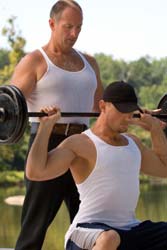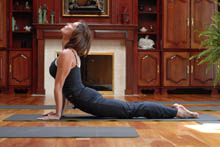Your Odds of Dying Too Early?
What is “Normal” Aging, and
How Can You Help Slow Down the Clock?
by www.SixWise.com
What is your ideal target age to live to? Many people today live to and past 100. We all want to live a healthy life filled with happiness and no regrets.
|

You’ve heard it all before ... a healthy diet and exercise can reduce your risk of disease and even slow down the aging process. But the truth is, it really can. So what are you waiting for? Today we will give you every reason and way to eliminate the excuses to quickly and affordably get healthy starting this very moment … improved health with all gain, and no pain financially and time wise for you and your loved ones!
|
We will share how to live your life healthier now and at a higher quality of life with less potential ill concerns for many more years to come.
We all have different reasons to live longer, but yet most end up the same: To spend more time with our children, grandchildren and loved ones. We nearly all have loving memories of our cherished grandparents, which we seek to have as many years as possible while in good health with those we too love so dearly.
The average life expectancy in the United States is 77.7 years. However, as far as aging goes, the rate is far from average. Individuals age at entirely different rates. Even different organs within the same person can age at varying speeds.
In order to reduce your “physical stages of dying” too early, it’s wise to first find out what your greatest risks of death are from … and then learn the steps to help prevent them. The good news is that many of the top risks can be dramatically influenced by your own habits and behaviors.
The Leading Causes of Death
Causes of death are far from precise. They vary depending on your age (teenagers face different threats than the elderly, etc.) and also shift over time based on environmental and dietary changes, medical advances, and so forth.
That said, LiveScience compiled a list of potential causes of death, along with an estimate of your lifetime odds of passing on due to that cause.
Your Potential Cause of Death
(you may be at greater risk if you have a family genetic history of a disease or a behavior that expresses / causes illness) |
Average Lifetime Odds
Some odds can be improved with healthy eating/diet & proper daily exercises |
Heart Disease:
(Increased rates due to increased hours sitting) |
1-in-5 |
Cancer:
(diet, smoking, and lack of exercise can increase odds) |
1-in-7 |
| Stroke: |
1-in-23 |
| Chronic lower respiratory diseases: |
1-in-24 |
| Accidental Injury: |
1-in-24 |
Diabetes:
(diet, and lack of exercise can increase odds) |
1-in-26 |
| Alzheimer's disease: |
1-in-28 |
Influenza and Pneumonia:
(including swine flu H1N1) |
1-in-29 |
Motor Vehicle Accident:
(Texting could increase to 1-in-65 by 2012) |
1-in-100 |
| Intentional Self-harm / suicide: (primarily under the age of 30) |
1-in-121 |
| Falling Down: |
1-in-246 |
| Assault by Firearm: |
1-in-325 |
| Fire or Smoke: |
1-in-1,116 |
| Natural Forces (heat, cold, storms, quakes, etc.): |
1-in-3,357 |
| Electrocution: |
1-in-5,000 |
| Drowning: |
1-in-8,942 |
| Air Travel Accident: |
1-in-20,000 |
| Flood (included also in Natural Forces above): |
1-in-30,000 |
| Legal Execution: |
1-in-58,618 |
| Tornado (included also in Natural Forces above): |
1-in-60,000 |
| Lightning Strike (included also in Natural Forces above): |
1-in-83,930 |
| Snake, Bee or other Venomous Bite or Sting: |
1-in-100,000 |
| Earthquake (included also in Natural Forces above): |
1-in-131,890 |
| Dog Attack: |
1-in-147,717 |
| Tsunami (included also in Natural Forces above): |
1-in-260,000 |
Asteroid Impact:
(could increase by 2012 to 1-in-290,000) |
1-in-500,000 |
| Fireworks Discharge: |
1-in-615,488 |
While some of these causes of death cannot be avoided, the top causes often can be.
What is “Normal” Aging?
Aging occurs at varying rates, often due to lifestyle factors. But according to the Baltimore Longitudinal Study of Aging, which involved screening volunteers aged 20 to 90 every two years for physiological and psychological changes, found that some generalities could be made. As reported by the U.S. National Institutes of Health, National Institute on Aging, these include:
-
Heart muscles thicken with age, while maximal oxygen consumption during exercise declines in men by about 10 percent with each decade of adult life and in women by about 7.5 percent.
-
Arteries tend to stiffen, which means your heart needs to supply more force to propel the blood forward.
-
Maximum breathing (vital) lung capacity may decline by about 40 percent between the ages of 20 and 70.
-
The ability of individual brain neurons to function may diminish with age.
-
Kidneys gradually become less efficient at extracting wastes from the blood.
-
Bladder capacity declines. Urinary incontinence, which may occur after tissues atrophy, particularly in women, can often be managed through exercise and behavioral techniques.
-
Typically, body fat gradually increases in adulthood until individuals reach middle age. Then it usually stabilizes until late life, when body weight tends to decline. As weight falls, older individuals tend to lose both muscle and body fat.
-
Without exercise, estimated muscle mass declines 22 percent for women and 23 percent for men between the ages of 30 and 70. Exercise can slow this rate of loss.
-
Bone mineral loss begins to outstrip replacement around age 35. This loss accelerates in women at menopause. Regular weight-bearing exercise can slow bone loss.
-
Difficulty focusing close up may begin in the 40s; the ability to distinguish fine details may begin to decline in the 70s. From 50 on, there is increased susceptibility to glare, greater difficulty in seeing at low levels of illumination, and more difficulty in detecting moving objects.
-
It becomes more difficult to hear higher frequencies with age. Even older individuals who have good hearing thresholds may experience difficulty in understanding speech, especially in situations where there is background noise.
-
Personality is extraordinarily stable throughout adulthood. Generally, it does not change radically, even in the face of major events in life such as retirement, job loss, or death of loved ones.
The important point to remember here is not how your body will react as you age, but rather that you can influence the rate at which you age by making positive changes to your lifestyle.
What this means is that the “average” signs of aging described above may occur much later in life for you, or even not at all.
Clues That Your Aging Rate May be Going Too Fast
“Diet and exercise are thought to have a major impact on a constellation of changes that are common with advancing age. These include higher levels of fats or lipids in the blood, changing levels of blood sugar and insulin, a tendency toward obesity, and increased central body fat that settles around the waist and abdomen,” according to the National Institute on Aging.
This cluster of symptoms is now referred to as metabolic syndrome, also known as Syndrome X, insulin resistance syndrome, and dysmetabolic syndrome. If you have three or more of the following symptoms, you may be at risk:
-
High blood pressure
-
High blood sugar levels
-
High levels of triglycerides, a type of fat, in your blood
-
Low levels of HDL (good cholesterol) in your blood
-
Too much fat around your waist (specifically a waistline of 40 inches or more for men and 35 inches or more for women (measured across the belly))
What makes metabolic syndrome so dangerous is that this cluster of symptoms significantly increases your risk of heart disease, stroke and type 2 diabetes.
Again, the good news is that metabolic syndrome is a condition you can avoid, or recover from if you already have it, as it's long been known that metabolic syndrome is influenced by lifestyle choices including a healthy diet and exercise.
Fewer Americans Leading a Healthy Lifestyle
Unfortunately, as it becomes increasingly clear that a healthy lifestyle can help you prevent disease, fewer Americans are taking the advice.
According to a comparison by investigators from the Medical University of South Carolina of results from two large-scale studies of the U.S. population, the number of people adhering to five healthy habits (exercising 12 times a month or more, not smoking, eating five or more fruits and vegetables daily, moderate alcohol use and maintaining healthy weight) has decreased from 15 percent during 1988-1994 to 8 percent during 2001-2006.
But you have a choice right now. Will you take the steps within your power to stay healthy and help prevent disease?
How to Live the Longest, Healthiest Life Possible
Life should become better as we age, as we get to know our real selves and become more comfortable in our own skin. But in order to age gracefully, it helps to be in the best shape possible, both physically and mentally.
So as you work on embracing the positive sides of aging, there are some things you can do to keep the negatives to a minimum.
- Eat a healthy diet focused on fresh instead of processed foods, without a lot of simple sugars.
As you start adding more fruits and veggies to your diet, you can help maximize nutrient absorption from these nutrient-rich foods using the plant-based enzyme supplement, AbsorbAid Platinum from NutritionsFinest.com.
This vegetable-based digestive enzyme system combines its effective ratio of proteases, amylases, lipases and cellulases with two "acid-tolerant" bacteria or a probiotic combination, Lactobacillus acidophilus and Bifidobacterium bifidum, to help break down all food groups and maximize nutrient absorption from the food you eat.
Every day we’re exposed to chemicals in our food and water, pollution in our air, and emotional stress in our lives. Over time, these toxins accumulate in your body and can manifest as insomnia, fatigue, digestive problems, aches and pains or even chronic disease.
Detoxification gives your body a chance to rest, clear out toxins and become nourished. Generally this is done by first removing and eliminating toxins, then providing your body with healthy nutrients.
You can also support the removal of toxins from your body using HMD,™ the natural heavy metal chelator from DrHMD.com. Dr. Georgiou, who is the inventor of HMD,™ has been doing pilot studies and says:
“We have been researching the effectivness of HMD in chelating xenobiotics such as bisphenol A and phthalates as we were seeing women with irregular periods for years regulating while using HMD.
Even though heavy metals can play a role in hormonal imbalances, we identified that is very possible that HMD is also chelating these xeno-oestrogens (hormone-mimicking molecules) such as BPA and other chemicals from plastics and cosmetics.
When we ran small pilot studies we indeed found that this was the case and are now seeking funding to pursue this avenue of research with a larger sample of people.”
So if you are concerned about the effects of environmental chemicals, then you should not hesitate to take HMD, which will certainly get rid of a variety of toxic metals and possibly chemicals as well. Use it with all the family -- it is considered a gentle and natural chelator that can be used by all http://drhmd.com/.
|
Stay “Lean and Mean” by Nourishing Your Mind-Body Connection

SheaNetics from MySheaNetics.com gives you the practical tools to get into shape and kick your health to ever higher levels, no matter what your age.
 Each nearly one hour workout is a new blend of the-best-of-the-best from Yoga, Pilates, Tai Chi, Martial Arts, Gyro-Kinesis, Dance and MORE -- guiding you through unique sequences of movements that strengthen, sculpt, build core and increase flexibility! Each nearly one hour workout is a new blend of the-best-of-the-best from Yoga, Pilates, Tai Chi, Martial Arts, Gyro-Kinesis, Dance and MORE -- guiding you through unique sequences of movements that strengthen, sculpt, build core and increase flexibility!
Separately (Each DVD) List Price ($95.95)
Your Special Price Just $59.00!
NEARLY A 30% SAVINGS + Free Shipping
Order your 6-PACK SheaNetics DVD/CD workout collection from MySheaNetics.com today!
|
It’s during this time that your body is rebuilt and repaired.
According to NIA:
“Regular physical activity may be the most important thing an older person can do to stay healthy and self-reliant. In fact, the more exercise you can do in later life, the better off you’ll be.
Studies suggest regular, sustained exercise can help prevent or delay some diseases and disabilities as people grow older. And, in some cases, it can actually improve some of these conditions in older people who already have them.
In a study conducted at Tufts University in Boston, for instance, some people age 80 and older were able to progress from using walkers to using canes after doing simple muscle-building exercises for just 10 weeks.
In addition, physical activity can improve your mood, lessen your risk of developing adult-onset diabetes, slow bone loss, and reduce your risk of heart attack and stroke.”
If you’re looking for an exercise program you can do right from your own home, we highly recommend adding SheaNetics from MySheaNetics.com, a mind-body workout, to your exercise routine.
SheaNetics, founded by fitness expert Shea Vaughn, blends ancient and contemporary movements with eastern philosophy, creating a stylized approach to fitness designed to improve the quality of today’s western living.
Shea spent years researching and teaching in the commercial fitness industry and has a first-hand understanding of the physical, mental and emotional benefits of living a life of exercise.
The range of SheaNetics students are impressively diverse from 25- to 75-year-olds, men and women, fitness buffs and athletes, people who want to get in shape, those who wish to maintain their present state of fitness and many who want to take it to a higher level.
-
Stay active, socially and mentally. By reading, doing crossword puzzles, learning new things, working part-time and socializing you can help keep your brain cells strong.
So take charge of your life and your health now by making the positive changes described above. As NIA says:
“Chronic diseases and disability were once thought inseparable from old age. This view is changing rapidly as one disease after another joins the ranks of those that can be prevented or at least controlled, often through changes in lifestyle.”
Recommended Reading
What is Americans’ Biggest Fear?
Aging Gracefully: Enjoy a Vital, Fulfilling Life Regardless of Age
Sources
U.S. National Institutes of Health, National Institute on Aging
LiveScience May 27, 2009
CDC FastStats Deaths and Mortality
LiveScience January 5, 2005